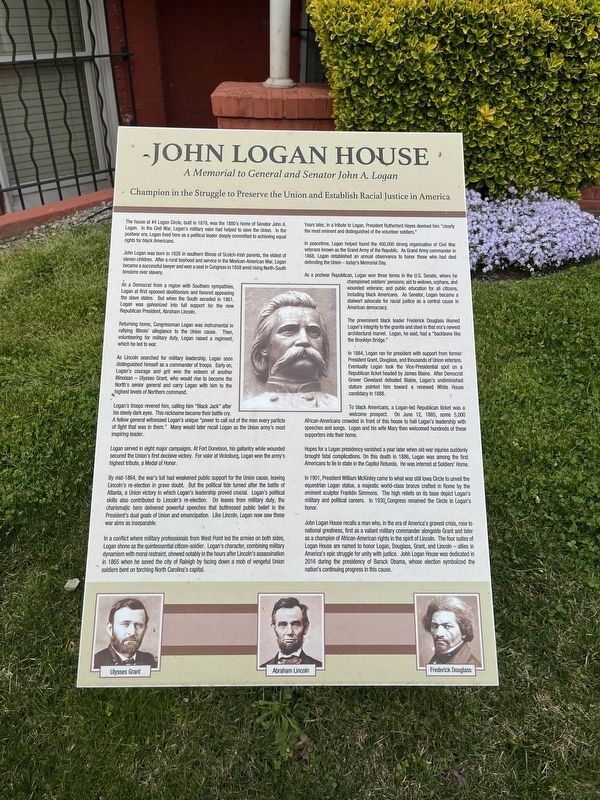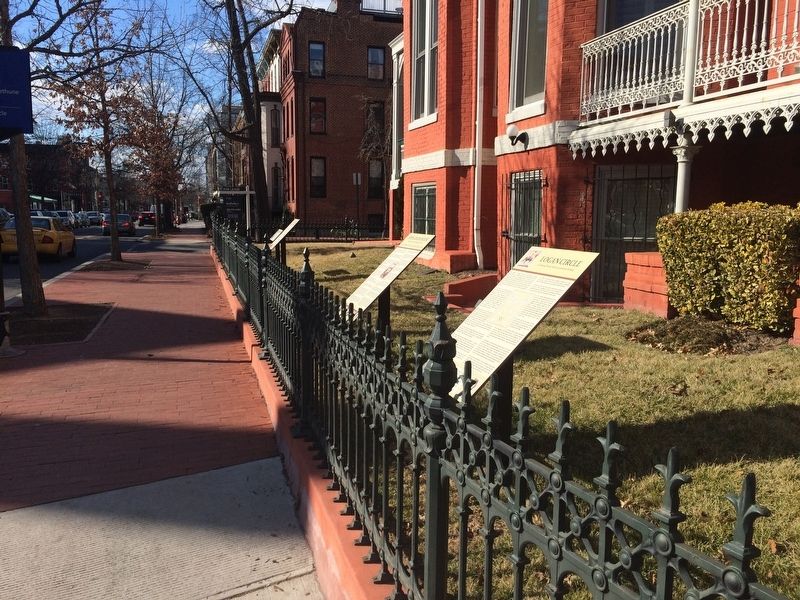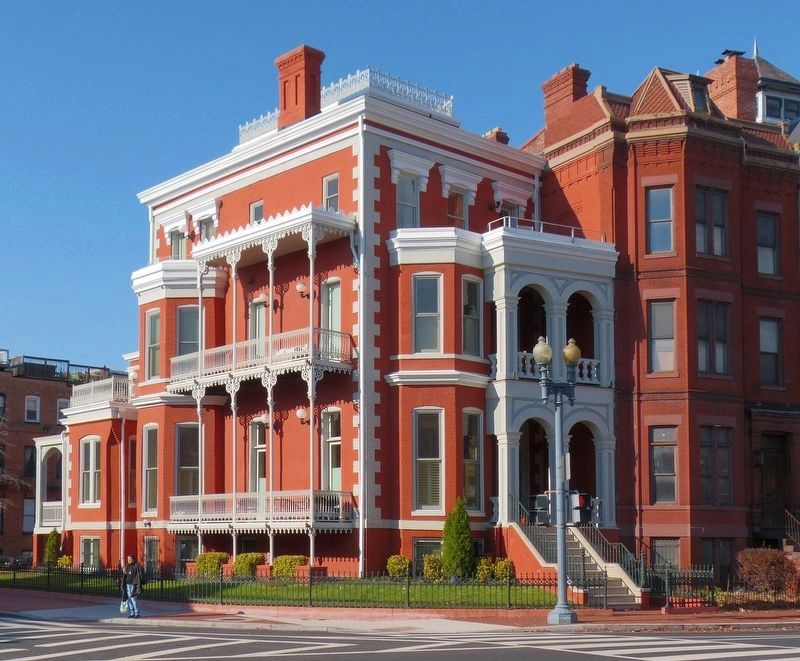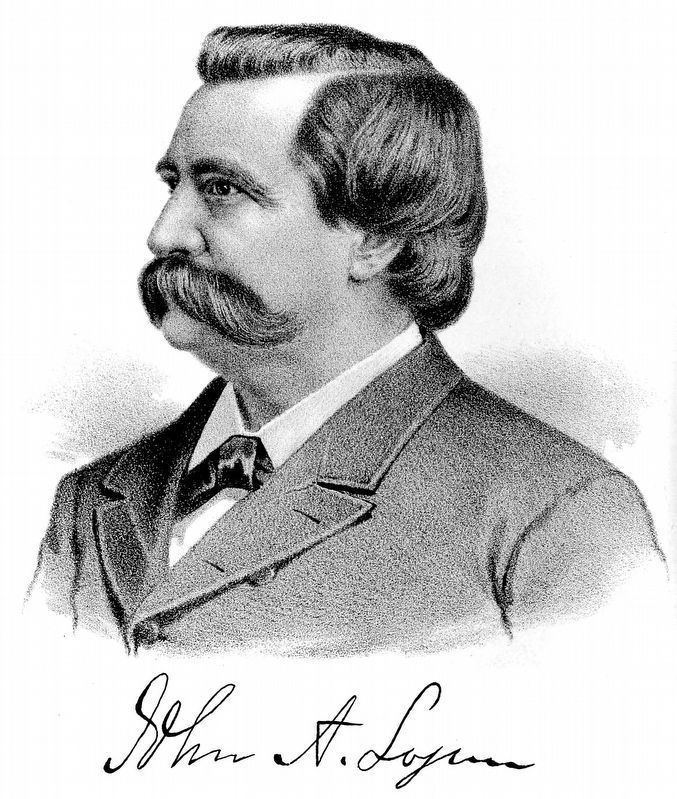Logan Circle in Northwest Washington in Washington, District of Columbia — The American Northeast (Mid-Atlantic)
John Logan House
A Memorial to General and Senator John A. Logan
— Champion in the Struggle to Preserve the Union and Establish Racial Justice in America —
The house at #4 Logan Circle, built in 1878, was the 1880's home of Senator John A. Logan. In the Civil War, Logan's military valor helped to save the Union. In the postwar era, Logan lived here as a political leader deeply committed to achieving equal rights for black Americans.
John Logan was born in 1826 in southern Illinois of Scotch-Irish parents, the eldest of eleven children. After a rural boyhood and service in the Mexican-American War, Logan became a successful lawyer and won a seat in Congress in 1858 amid rising North-South tensions over slavery.
As a Democrat from a region with Southern sympathies, Logan at first opposed abolitionism and favored appeasing the slave states. But when the South seceded in 1861, Logan was galvanized into full support for the new Republican President, Abraham Lincoln.
Returning home, Congressman Logan was instrumental in rallying Illinois' allegiance to the Union cause. Then, volunteering for military duty, Logan raised a regiment, which he led to war.
As Lincoln searched for military leadership, Logan soon distinguished himself as a commander of troops. Early on, Logan's courage and grit won the esteem of another Illinoisan — Ulysses Grant, who would rise to become the North's senior general and carry Logan with him to the highest levels of Northern command.
Logan's troops revered him, calling him "Black Jack" after his steely dark eyes. This nickname became their battle cry. A fellow general witnessed Logan's unique "power to call out of the men every particle of fight that was in them." Many would later recall Logan as the Union army's most inspiring leader.
Logan served in eight major campaigns. At Fort Donelson, his gallantry while wounded secured the Union's first decisive victory. For valor at Vicksburg, Logan won the army's highest tribute, a Medal of Honor.
By mid-1864, the war's toll had weakened public support for the Union cause, leaving Lincoln's re-election in grave doubt. But the political tide turned after the battle of Atlanta, a Union victory in which Logan's leadership proved crucial. Logan's political skills also contributed to Lincoln's re-election. On leaves from military duty, the charismatic hero delivered powerful speeches that buttressed public belief in the President's dual goals of Union and emancipation. Like Lincoln, Logan now saw these war aims as inseparable.
In a conflict where military professionals from West Point led the armies on both sides, Logan shone as the quintessential citizen-soldier. Logan's character, combining military dynamism with moral restraint, showed notably in the hours after Lincoln's assassination in 1865 when he
Years later, in a tribute to Logan, President Rutherford Hayes deemed him "clearly the most eminent and distinguished of the volunteer soldiers."
In peacetime, Logan helped found the 400,000 strong organization of Civil War veterans known as the Grand Army of the Republic. As Grand Army commander in 1868, Logan established an annual observance to honor those who had died defending the Union — today's Memorial Day.
As a postwar Republican, Logan won three terms in the U.S. Senate, where he championed soldiers' pensions; aid to widows, orphans, and wounded veterans; and public education for all citizens, including black Americans. As Senator, Logan became a stalwart advocate for racial justice as a central cause in American democracy.
The preeminent black leader Frederick Douglass likened Logan's integrity to the granite and steel in that era's newest architectural marvel. Logan, he said, had a "backbone like the Brooklyn Bridge."
In 1884, Logan ran for president with support from former President Grant, Douglass, and thousands of Union veterans. Eventually Logan took the Vice-Presidential spot on a Republican ticket headed by James Blaine. After Democrat Grover Cleveland defeated Blaine, Logan's undiminished stature pointed him toward a renewed White House candidacy in 1888.
To black Americans, a Logan-led Republican ticket was a welcome prospect. On June 12, 1885, some 5,000 African-Americans crowded in front of this house to hail Logan's leadership with speeches and songs. Logan and his wife Mary then welcomed hundreds of these supporters into their home.
Hopes for a Logan presidency vanished a year later when old war injuries brought fatal complications. On his death in 1886, Logan was among the first Americans to lie in state in the Capitol Rotunda. He was interred at Soldiers' Home.
In 1901, President McKinley came to what was still Iowa Circle to unveil the equestrian Logan statue, a majestic world-class bronze crafted in Rome by the eminent sculptor Franklin Simmons. The high reliefs on its base depict Logan's military and political careers. In 1930 Congress renamed the Circle in Logan's honor.
John Logan House recalls a man who, in the era of America's gravest crisis, rose to national greatness, first as a valiant military commander alongside Grant and later as a champion of African-American rights in the spirit of Lincoln. The four suites of Logan House are named to honor Logan, Douglass, Grant and Lincoln — allies in America's great struggle for unity with justice. John Logan House was dedicated in 2016 during the presidency
of Barack Obama, whose election symbolized the nation's continuing progress in this cause.
Erected by John Ritch, founder of John Logan House.
Topics and series. This historical marker is listed in these topic lists: Abolition & Underground RR • African Americans • Patriots & Patriotism • War, US Civil. In addition, it is included in the Former U.S. Presidents: #18 Ulysses S. Grant, the Former U.S. Presidents: #19 Rutherford B. Hayes, the Former U.S. Presidents: #22 and #24 Grover Cleveland, the Former U.S. Presidents: #25 William McKinley, and the Former U.S. Presidents: #44 Barack Obama series lists.
Location. 38° 54.584′ N, 77° 1.836′ W. Marker is in Northwest Washington in Washington, District of Columbia. It is in Logan Circle. Marker is at the intersection of P Street Northwest and Logan Circle Northwest, on the left when traveling east on P Street Northwest. Touch for map. Marker is at or near this postal address: 4 Logan Circle Northwest, Washington DC 20005, United States of America. Touch for directions.
Other nearby markers. At least 8 other markers are within walking distance of this marker. Logan Circle (here, next to this marker); No Braver Man Than John Logan (here, next to this marker); When Logan Rode The Battle Line (here, next to this marker); a different marker also named John Logan House (a few steps from this marker); 6 Logan (within shouting distance of this marker); Belford V. Lawson and Marjorie M. Lawson Residence (within shouting distance of this marker); Pratt House (within shouting distance of this marker); a different marker also named Logan Circle (within shouting distance of this marker). Touch for a list and map of all markers in Northwest Washington.
Additional commentary.
1.
An identical marker is adjacent to the entrance of the house itself.
— Submitted February 3, 2018, by Devry Becker Jones of Washington, District of Columbia.
Credits. This page was last revised on January 30, 2023. It was originally submitted on February 3, 2018, by Devry Becker Jones of Washington, District of Columbia. This page has been viewed 1,546 times since then and 195 times this year. Last updated on July 30, 2020, by John Ritch of Washington, District of Columbia. Photos: 1. submitted on April 13, 2022, by Devry Becker Jones of Washington, District of Columbia. 2. submitted on February 3, 2018, by Devry Becker Jones of Washington, District of Columbia. 3. submitted on December 20, 2018, by Allen C. Browne of Silver Spring, Maryland. 4. submitted on July 5, 2019, by Allen C. Browne of Silver Spring, Maryland.



